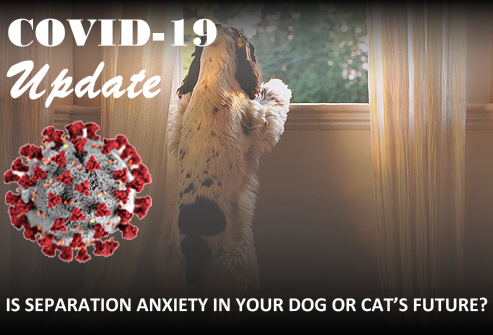As the Novel Coronavirus Covid-19 begins to level off, we can expect many pets to suffer from separation anxiety. As life begins to normalize and people are starting to go back to work, kids going back to school – our pets that became accustomed to having the family around, suddenly find themselves alone. When the guardians are gone, a certain sense of loss sets in.
Separation anxiety is the inability to cope when loved ones leave, and most often occurs when the pet realizes it is alone. Since the pet’s frantic search for its human companions often results in some damage, or the stress to its bodily functions often creates house soiling accidents, owners almost invariably attribute the effects of separation anxiety to spite work. But I assure you, they really do not stay up late at night thinking of ways to get even with you! Although most trouble a pet gets into occurs when it is left alone, it usually has a lot more to do with boredom, loneliness, and in many cases separation anxiety.
Symptoms of separation anxiety may range dramatically in the way in which they are expressed by the pet. He may run frantically from room to room, damage his owner’s personal belongings and lose control of his elimination functions. In his desperation to get out and find his loved ones, he may chew through window coverings, dig holes through walls or leap through glass windows. Other pets exhibit their stress more quietly, not eating or drinking, and may be found cowering in the corner or hiding under the bed. Some pets will even go so far as self-mutilation, because of their nervousness they lick and chew on themselves until their skin is raw and bloodied.
Whether the symptoms are severe, merely create a nuisance for you, or simply create nervous anxiety for the pet, it’s important to understand that the real problem stems from insecurities and lack of confidence. Once you understand that this is not spite, the best approach to dealing with separation anxiety is prevention – never letting it begin in the first place. However, in most cases this is a pre-existing phobia. Take heart – separation anxiety attacks can always be helped and the symptoms alleviated if you embark on a gradual program of desensitization.
STEP 1
Create a very pleasant home environment, with a special emphasis on wonderful things that occur only when your pet is left alone. Leave a radio on a talk station to help comfort the pet and to help drown out disturbing noises from the outside world. In some severe cases owners may even tape record their own conversations and
play them back for the pet when they leave the house. For some pets, this is just the extra soothing factor they may need, but other pets may become more frantic in their search for their beloved human family. (You’ll need to gauge your pet’s reaction.) Very special items should be left for him when it’s time to leave the house. Favorite toys and treats should be placed around your home. The idea is to have your pet begin to associate pleasant things with your departure.
STEP 2
An exercise program is extremely important in assisting your pet in dealing with stress. Exercise is a known stress reducer and, as with human beings, pets may fare remarkably better when exercise is included in their daily routine, particularly when done an hour or two before you leave your home. Remember, a tired pet is more likely to sleep and is less likely to be destructive.
STEP 3
When all of the above steps are in place, begin a gradual weaning program. Go from room to room, standing outside a closed door and talking to your pet through the door. Begin the procedure for a few seconds only, then open the door and lavish great praise on him. Continue the procedure and slowly increase the period of time he is in the other room and the distance away from the door, until he is in the opposite end of the home. As he adjusts to this step, expand the desensitization program by standing outside the front or back door, again talking to him the entire time. Again, gradually increase the time and the distance from the door as he adjusts. Then it’s time to leave your home entirely, for a minute only, returning with plenty of hugs and kisses and praise. Expand this program a few minutes at a time until he is secure in being left behind.
As with any family member, our pets are subject to developing psychological problems.
They deserve to be treated with respect and every effort should be made to help them through their troubled times. We brought them into our human environment and must stand by them when their inability to cope surfaces. By carefully following the steps above with patience and understanding, you’ll ease their suffering and be able to come home to your home intact.




